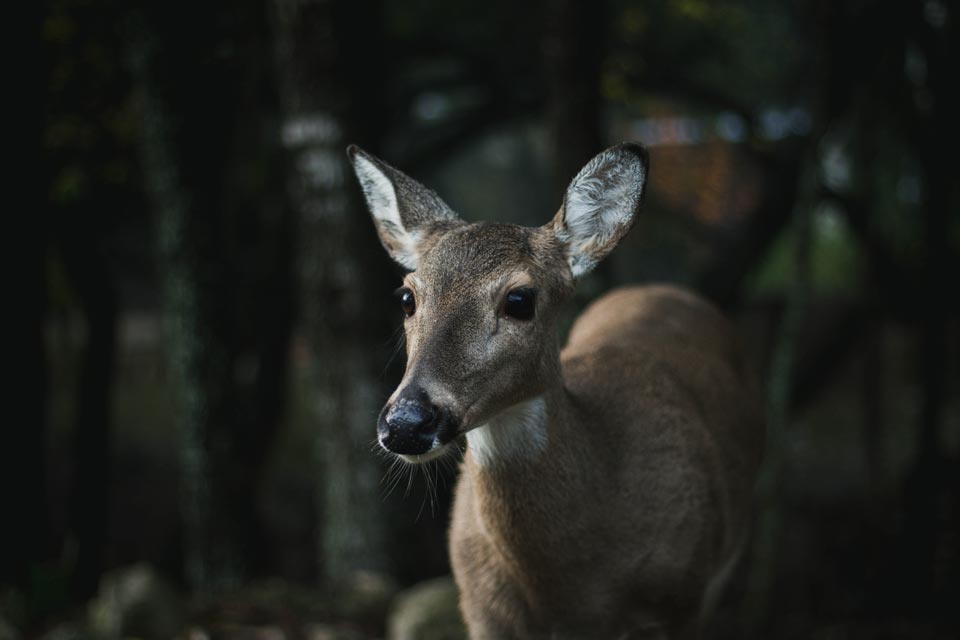It’s hard to believe we’re halfway through the field season already. If you include training, we’re 7 weeks into a 14 week job posting.
Ay-yi-yi, how time flies!
We were down a crew member due to illness the first two days of this week. I wasn’t too worried on Monday because our first plot was a relatively easy one with direct access off of a roadway in Rothrock. We were paid a surprise visit after lunch by the fawn crew, and they helped us repair some fences that were in dire need of some new posts and fencing. That helped a lot, and as a result we also managed to complete canopy photos on Monday!

Thanks to the fawn crew we managed to repair some fences in desperate need of attention on Monday despite being down a crew member. Unfortunately, it appears the fence nearest to the road had been cut and a section removed. Spread the word: do not disturb! These are important to our research!
Tuesday, however, I had some concerns because our plot fell inside of a commercial deer fence. Fences mean lots of seedlings. The count for Tuesday? 807. Not nearly as impressive as our 1,500 seedlings last week, but this site has a lot of saplings that have since limited the seedling response.

While not as dense as one of our plots last week, this plot has a lot of oak regeneration and is relatively open making for hot humid work this week!
I should have known better than to worry! My continuously kick-butt crew managed to complete all of the surveys for the day and we only worked an extra half hour on Tuesday. This is especially impressive because it was the hottest day we’ve had all season and the plot doesn’t have a lot of shade (timber harvest = fewer overstory trees and less shade). We were baking, and the humidity was something else. They still continued to impress and get the work done. Really, they are the best!
As we were sitting there baking in the sun shortly after lunch, Aaron spotted a very nice patch of Indian cucumber-root (see The Deer Plate Special) that was easily 3.5-ft tall. Now, despite its tasty cucumber-like rhizome I usually don’t condone digging up Indian cucumber-root anywhere near our plots. Why? I worry it will affect our data (those individuals may eventually colonize plots!) and those that have the tastiest and biggest rhizomes are the ones most likely to replenish the seed bank. (Remember how I said those browsed stay small and do not produce flowers and fruits?)
Tuesday, I made an exception. Because we were in a deer fence, there were easily 10-12 similarly sized reproductive plants that could produce new plants in the area. Plus, I was curious. How big is the rhizome on something that tall? And (guilty as charged): How does it TASTE?
As a reward for being as productive with 3 people as we were with 4, I took the opportunity to take some photos of the specimen (for science!) and split the rhizome 3 ways. I can say with certainty, it tastes pretty darn good.


One of the tallest Indian cucumber-root plants I’ve ever seen! Nice find, Aaron!
Wednesday we were back to full strength with our 4th crew member returning. Good thing too, because we visited a plot full of lots and lots of rubus (AKA a plot full of lots and lots of prickles and featured in The Deer Plate Special). I’ve talked this plot up all year, promising there would be black raspberries and ripe blueberries to make up for our pain and suffering. They’ve been there the last two years, and really it’s the only thing that makes the plot tolerable. Yet, this year, nothing. Not one ripe berry. Not a blueberry or black raspberry in sight. Talk about disappointment.
Thursday we were back to collecting soils, meaning our marathon of vegetation survey days is finally coming to a close. There were fewer rocks than last time, too, so collection went relatively smoothly. We had a few fences to fix, but even with that added work we still had time to clean out and organize the truck. I never have figured out how it gets so messy, but it does!

Back together again! The crew collecting soils inside of a fence on Thursday.
Another week down, 7 more to go!
This week’s Deer Plate Special:

Common Name: False Solomon’s Seal or Solomon’s Plume
Scientific Name: Maianthemum racemosum
Description: A perennial understory herbaceous plant of the Asparagus family that occurs in moist woods. Leaves are usually 4 or more occurring along the stalk in an alternating pattern. Long parallel veins run the full length of the leaf, and fine hairs occur on the leaf edge resembling eyelashes in direct sunlight. Flowering occurs at the end of the plant with clearly alternating stalks of flowers (a raceme). Flowering occurs in May and fruit forms in June. Fruits are speckled and abundant.


Size: 2’’ to +3ft in height depending on site conditions and browsing history. Like Indian cucumber-root, frequent browsing will reduce the size of individual plants and halt reproduction.
Wildlife Value: Birds and small mammals eat this plants’ berries. Deer browse the foliage.
Ph.D graduate student
